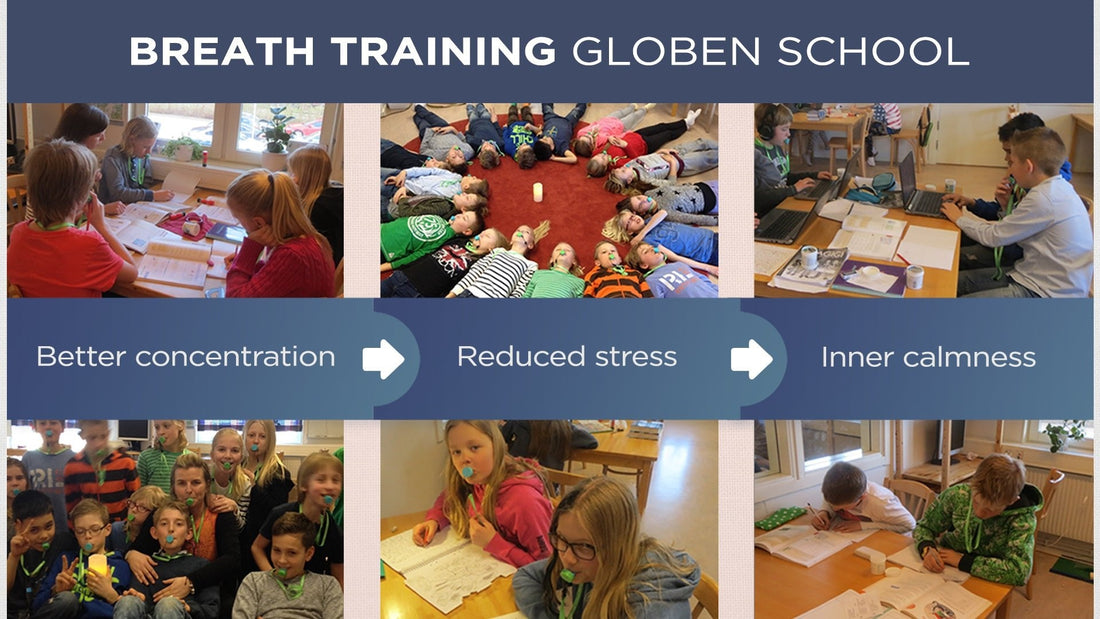
Breathing retraining in school increases concentration, reduces worry and stress
Magdalena Lagerström from SHRI Yoga is a certified Conscious Breathing instructor.

During a four-week period, she has conducted a pilot project at Globen-school in Alingsås, Sweden, in which 22 students in fourth and fifth grade practiced Conscious Breathing Retraining.
The students received about three hours of education on how the way we breathe affects our health, the characteristics of good and poor breathing habits, as well as simple tips and exercises to improve their breathing habits at school, in their free time, and during physical activity.
Furthermore, the students practiced with the Relaxator Breathing Retrainer and did different exercises aimed at creating free and well-functioning airways, as well as raising the awareness of their body and breathing in their daily lives.
The breathing practice was done for ten minutes each day, for a total of about three hours. On five occasions, the practice was lead by Magdalena, and on fifteen occasions by the student’s teacher, Lisa Bogeskär.
Questionnaire
The students were asked to answer these questions at the first and last meet-up. Each question results in a score from one through five points. The higher the score, the better, and the maximum score is 30. Furthermore, five statements are linked to each question, where each statement gives a minus point. A summary of the results showed an increase from 12,9 to 19,0 points - an increase by 48 percent.
| Before | After | |
|---|---|---|
| Points | 21.3 | 23.1 |
| Statements (minus points) | -8.4 | -4.1 |
| Sum total | 12.9 | 19.0 |
Increase: 48%

Evaluation
After finishing the project, the students were asked to rate how Conscious Breathing Retraining had affected their concentration, energy levels, mood, etc. Zero indicates no change at all and ten indicate a significant change.
According to the evaluation, the greatest impact, from the exercises and the understanding of the importance of the breath, was experienced on the ability to concentrate, the airways, and physical fitness, who were all rated a six. That’s a remarkably big change considering that they only invested about six hours in the project.
Our vision is that ALL school children should get the chance to assimilate this powerful piece of knowledge. And honestly, our kids are taught a thousand different things, but no-one learns how to breathe....even though it’s the most important function of the body. Isn’t that strange?
On a scale from 0 – 10, how has the breathing retraining affected:
| Concentration | 6 | Mood | 5 |
| Energy levels | 5 | Airways | 6 |
| Stress | 5 | Fear, worry, anxiety | 4 |
| Sleep | 5 | Physical fitness | 6 |
Comments from the students
In the evaluation, the students wrote down their reflections about the breathing project. 15 out of 22 children were also interviewed using video. The comments were almost exclusively positive. The recurring themes in the evaluation and interviews are:
- Improved ability to concentrate
- Less stress
- Increased inner calmness
14 out of 15 interviewees mentioned these things above, in their own words. One student said: “I’m not as stressed in the mornings anymore. I take it easy and think to myself that it doesn’t matter if I’m a minute late for school. But I am on time anyway. I don't like to rush, so it’s nice to be able to avoid doing it unnecessarily."
Several students felt that the classroom was quieter. When a math problem is tedious, for example, it's easy to interrupt a classmate or feel the need to move around. The student’s improved ability to concentrate and the decreased stress levels, made them interfere less with each other. One student said: “There’s not as much running around as there used to be, and there’s fewer who talk and interrupt.”
The interviews gives the feeling that a lot of the students have gotten a tool that will benefit them for the rest of their lives. Imagine learning how to handle stress and increase your ability to concentrate as early as when you’re eleven or twelve years old. What happens if we don’t learn to manage stress from a young age? Will our stress increase or decrease by the time we’re 30, 40, or 50 years old? It will likely have increased, right?
Many of the students have also been using their newfound breathing knowledge while engaging in physical activities like dancing, playing football, handball, and floorball. One student said: “When I play handball, I’m better at listen to the instructions from my coach and I make fewer mistakes. When I get to the subs bench, I breathe calmly through my nose, low down in my belly and by doing that, I’m alert and ready when heading out to the court again."

Lisa Bogeskär, Class Teacher

–I am very happy that my students and I got to try this. I’ve been interested in health and wellness since I was a teenager. It is obvious how good health affects the well-being of the children. Usually when it comes to well-being, there’s a lot of talk about the importance of movement and joyfulness.
What was new to me, and very interesting, was how we can put our breathing into focus. There’s not a lot of talk about this, apart from different types of yoga and relaxation techniques.
I found that the students were very curious and positive regarding this study. We got an introduction about how the study would play out and that’s when they were asked to fill out the questionnaire.
During our first lesson, the students were very curious and focused on what Magdalena said. The brief theory of the importance of good breathing habits helped a lot of the students who are into sports, like football and handball, to become even more interested.
I was impressed by their ability to express and reflect, already during the first week, on the calmness they felt during those daily breathing moments The students also began to think about how they, and their parents, were breathing.
One girl realized that she was breathing the complete opposite way (stomach out on the outbreath / stomach in on the inhale). I also received a message from a parent who had noticed that her daughter appreciated these moments and was much calmer and more content at home.
The breathing retraining made the students calmer
During these four weeks, we took a moment each day to practice the exercises Magdalena had given to us. That part of the day was something we all looked forward to. It was written out on our daily schedule, and it was often the students who reminded me when it was time.
If it was after a lunch break, sometimes they were already sitting at their desks with their Relaxators when I walked into the classroom. So, all in all, it was a very positive experience that the students enjoyed.
There were also times when I issued a break during longer work sessions for a moment of focus on the breathing. At these times, we didn’t bring out the Relaxator, but instead closed our eyes, took 10 to 15 calm breaths in and out through the nose and visualized an anchor sinking into our bellies.
We also did it before a test they had. On that occasion, one of the students told me he liked it and that it had made him feel calmer during the test.
Theory combined with exercises gives a good overall understanding
I really believe this is something all students could benefit from. I think it was important that the theory part was tied to the project to give the students a better understanding of how the breath can be affected if you do it the right way. I feel that my students were very content after these weeks.
The music teacher, who meet them once a week, felt they were very happy as a group. They were laughing with each other instead of at each other, which can sometimes be the case. I really believe this course has been positive for the group dynamic.
Personally, it’s made me become more aware of how I breathe in different situations and how the breath can help me when I’m feeling stressed or worried about something.
Now I also feel comfortable with a student in my group who has severe asthma. This student has occasionally struggled with shortness of breath, for example after lunch break. Before the breathing course, it was hard for me to handle, and we usually ended up calling her mother.
Since the course started, I’ve been able to calm the student down by sitting down and focusing on the basic breathing principles we’ve been taught. She has calmed down and been able to stay in the classroom, without needing to call her mom. It makes me feel hopeful!







